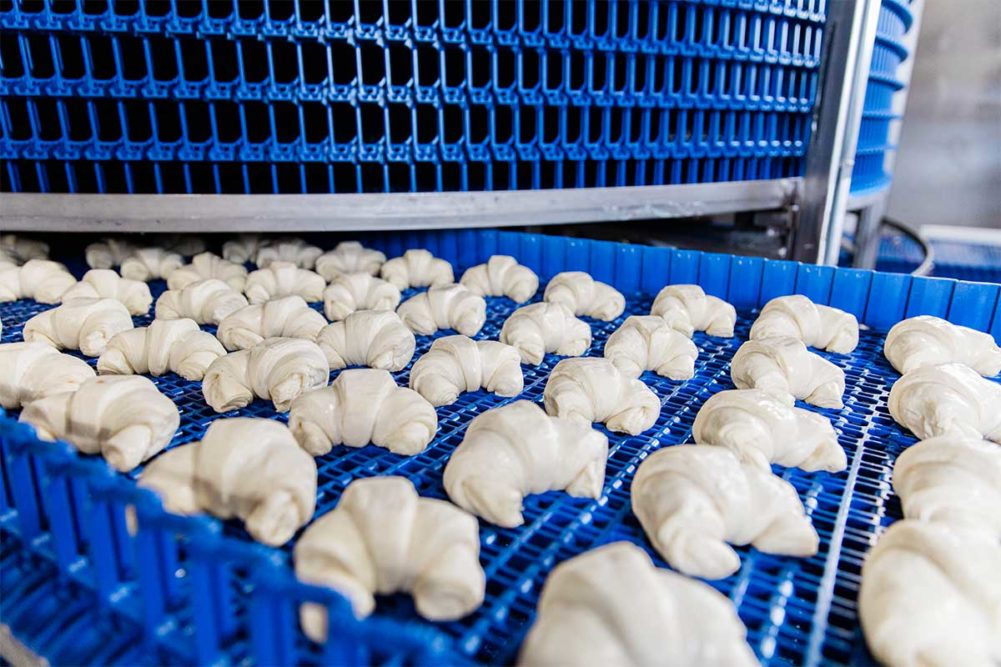Choosing the proper belting can also potentially impact energy efficiency while minimizing scheduled downtime.
Jonathan Lasecki, director of engineering, Ashworth Bros., recommended stainless steel belts for blast freezers, although the company is also exploring the development of plastic materials that can be used in such applications.
“At extreme cold temperatures down to -200˚F, plastic material can become brittle so stainless steel is the best material to maintain mechanical properties,” he said.
Maintaining air flow around the product provides the key to potential energy savings by reducing the time it takes to effectively freeze baked foods. Ashworth offers the Mono-Planer Omni-Grid and Tight Mesh Omni-Grid for spiral freezers.
“The density of the mesh surface is critical,” Mr. Lasecki said. “If you can keep the frost from building up on the belt, you can reduce your freeze time because you have better air flow.”
Straight tunnel freezers, he added, can feature wave technology that mechanically vibrates the belt to prevent baked foods from sticking to it.
“It’s like the scene in ‘A Christmas Story,’ the movie where the boy puts his tongue on the telephone pole when it’s -20℉, and it sticks,” Mr. Lasecki said. “You have to look at vibratory solutions and other types of applications. We look at the design of the mesh to minimize frost on the belt and sticking.”
For individual quick-frozen (IQF) applications, Messer recently introduced the Wave Impingement tunnel freezer that combines wave product agitation with high-velocity convective airflow to achieve rapid chilling and freezing of pizza toppings and other food products.
“By putting both of them in one package, you can get up to a 35% production increase with the same footprint compared to a conventional cryogenic freezing tunnel,” said Dan Morgan, director, food and beverage markets, Messer.
Bakers also don’t have to align products or pre-crust the bottom of baked foods to prevent sticking, he added.
Meanwhile, Linde offers the new generation of high-capacity Cryoline CWI freezers that combine IQF vibration movement with patented impingement technology. This system uses nitrogen as a cooling agent, delivering heat transfer rates two to three times those of standard tunnel freezers and making the application up to 20% more efficient, according to the company.
To minimize product sticking, David Bogle, lead engineer, spiral platforms, Intralox, suggested bakers explore acetal belting because of its strength in temperatures as low as -50°F in spiral freezers. If there are fire risks before a freezer, such as an oven, an Intralox fire-resistant belt called SELM can be chosen.
“Modular plastic belts take less energy to move as they weigh less and have lower friction values,” he said.
He added that the company’s engineers can consult on a bakery’s freezing process to potentially save energy and eliminate airflow waste so that products can be cooled more efficiently and quickly. Intralox DirectDrive systems allow for a positively driven spiral that results in 70% less tension than friction-driven systems and eliminates overdrive, which is the leading cause of unexpected downtime in spirals.
For companies looking for sustainable alternatives, renewable energy options can provide several benefits, especially in the global marketplace.
“As a greener economy is becoming more and more a reality, generating electricity from renewable sources can indeed be an asset in providing partial shielding from volatile energy pricing that affects the operational cost of industrial freezers,” said Nicola Menardo, president of TP Food Group North America, the US arm of TP Food Group. “In addition, from a fiscal point of view, investments in renewable energy can generate savings anytime governments provide incentives to ‘green transitions.’ ”
Eliminating unnecessary downtime is another surefire way to enhance a freezer’s efficiency. However, who knows what trouble lurks behind closed doors in a spiral system or inside a tunnel operating in arctic conditions?
Mr. Bogle said running to failure always costs far more money in the long term. Intralox offers real-time tension monitoring to help identify early issues with spiral belting. In the event of a breakdown, modular plastic belting can be fixed with no special tools or need for sanitizing after the repair.
Mr. Lasecki said Ashworth’s Smart Spiral system monitors key operating parameters of a spiral system and can be adapted for use on straight-running systems.
“Using the Smart Spiral, plant maintenance and engineering can monitor the health of a system and note changes that occur over time that indicate failing components,” he said. “Such information allows for the repair of failing components before a catastrophic and expensive surprise failure.”
Ashworth Bros. recently expanded its monitoring systems to other parts of the production line with its Smart Oven predictive maintenance system with heat-resistant vibration, zone temperature and gas usage sensors in another type of extreme condition.
“As long as sensors can gather the data, the system can let you know the performance of the piece of equipment that you would like to monitor,” Mr. Lasecki said. “It’s like a car. When you start it in the morning and you hear a grumbling, growling sound, you don’t just say, ‘OK. It starts,’ and go to work. Hopefully, you say, ‘Hold on. Let’s figure this out. Maybe there’s a bearing going bad. Let’s look a little further and don’t wait until suddenly it doesn’t start.’ It all comes down to being aware of your equipment, and that’s all a part of sanitation and maintenance.”
This article is an excerpt from the September 2022 issue of Baking & Snack. To read the entire feature on Cooling & Freezing, click here.





